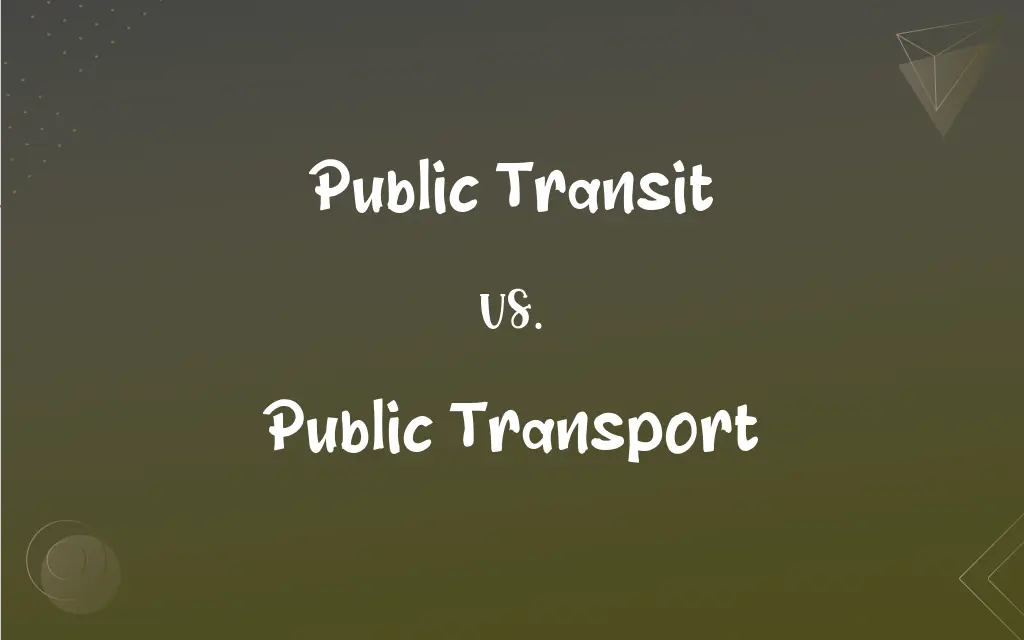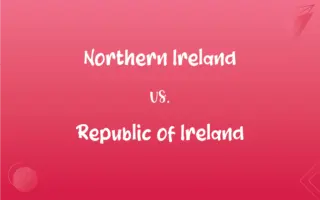Public Transit vs. Public Transport: What's the Difference?
Edited by Aimie Carlson || By Janet White || Published on January 15, 2024
Public transit refers to a local transportation system for the public, while public transport encompasses all modes of transportation accessible to the public.

Key Differences
Public transit typically signifies a local or regional transportation system like buses or subways, intended for short-range travel within a city. Public transport, however, is a broader term including all transport facilities available to the public, encompassing local, national, and international travel options.
Public transit is often characterized by scheduled services within urban areas, serving daily commuters. Public transport extends beyond this, including long-distance trains, airplanes, and even ferries, serving a variety of travel needs.
Public transit systems are crucial in reducing urban congestion and are typically managed by local or regional authorities. Public transport systems may include private or government-operated services covering a wider range of transportation modes.
Accessibility is a key aspect of public transit, focusing on dense urban networks for ease of commuting. Public transport, in its larger scope, also emphasizes accessibility but includes considerations for longer distances and different regions.
Public transit plays a significant role in sustainable urban development, while public transport, with its broader reach, contributes to both urban and intercit
ADVERTISEMENT
Comparison Chart
Scope
Local or regional
Local, regional, national, international
Types of Vehicles
Buses, trams, subways
Buses, trains, planes, ferries
Function
Primarily urban commuting
All-purpose travel, including long-distance
Management
Often local or regional authorities
Mix of private and government operations
Focus
Urban congestion reduction and local accessibility
Broad accessibility, including intercity
ADVERTISEMENT
Public Transit and Public Transport Definitions
Public Transit
Accessibility-Oriented.
Public transit aims to provide accessible transport within the city.
Public Transport
Inter-city and International Travel.
For international travel, public transport like airplanes is essential.
Public Transit
Managed by Local Authorities.
The municipal government oversees the public transit system.
Public Transport
Diverse Travel Options.
Public transport offers various options like subways, trains, and planes.
Public Transit
Scheduled Local Services.
Public transit services, like the local bus, run on a fixed schedule.
Public Transport
Broad Accessibility.
Public transport is designed to be accessible to all, regardless of the destination.
Public Transit
Eco-Friendly Urban Travel.
Using public transit, like trams, helps reduce urban pollution.
Public Transport
General Public Transportation.
Public transport includes everything from city buses to cross-country trains.
Public Transit
Urban Commuting System.
The city's public transit network of buses and subways facilitates daily commuting.
Public Transport
Private and Government Operations.
Public transport services are provided by both private companies and the government.
FAQs
What is the primary function of public transit?
Public transit primarily serves local commuting needs within urban areas.
Are public transport services more diverse than public transit?
Yes, public transport includes a wider range of services, including international travel.
Do public transport systems include maritime travel?
Yes, public transport encompasses maritime options like ferries.
Can public transit be used for long-distance travel?
Public transit is generally designed for short-range, local travel, not long distances.
Is public transit more eco-friendly than private transportation?
Generally, public transit is more eco-friendly due to reduced per capita emissions.
Are all public transport services operated by the government?
No, public transport can be operated by both private entities and government agencies.
Do public transit systems usually cover rural areas?
Public transit is primarily focused on urban areas, with less coverage in rural regions.
Is public transit cheaper than other forms of transportation?
Public transit is often more affordable than private transport, especially for daily commutes.
Are bicycles considered part of public transit?
Bicycles can be part of public transit systems, especially in bike-sharing programs.
Do public transit systems require a lot of infrastructure?
Yes, public transit systems like subways and trams require significant infrastructure.
Can public transport help reduce traffic congestion?
Yes, efficient public transport can significantly reduce road congestion.
Is it common for cities to have integrated public transit systems?
Many cities aim for integrated public transit systems for seamless commuting.
Are public transit systems often subsidized by governments?
Yes, public transit systems are frequently subsidized to keep fares affordable.
Can tourists use public transport for sightseeing?
Yes, public transport is often used by tourists for both local and distant sightseeing.
Is accessibility a major concern in public transport?
Yes, ensuring accessibility for all is a key concern in public transport.
Are public transit fares typically lower than public transport fares?
Yes, public transit fares are usually lower, given the shorter travel distances.
Can public transport include private cars?
No, private cars are not considered part of public transport.
Are public transit and public transport the same in rural areas?
In rural areas, the distinction may blur, but generally, public transit is less prevalent there.
Do public transport systems contribute to tourism?
Yes, public transport is a key component of tourism infrastructure.
Is the environmental impact a consideration in developing public transport?
Yes, environmental impact is a significant factor in developing public transport systems.
About Author
Written by
Janet WhiteJanet White has been an esteemed writer and blogger for Difference Wiki. Holding a Master's degree in Science and Medical Journalism from the prestigious Boston University, she has consistently demonstrated her expertise and passion for her field. When she's not immersed in her work, Janet relishes her time exercising, delving into a good book, and cherishing moments with friends and family.
Edited by
Aimie CarlsonAimie Carlson, holding a master's degree in English literature, is a fervent English language enthusiast. She lends her writing talents to Difference Wiki, a prominent website that specializes in comparisons, offering readers insightful analyses that both captivate and inform.

































































